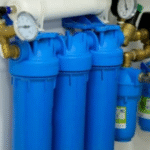Let’s be honest—most of us grew up trusting the water that came out of the faucet. It filled our glasses, washed our dishes, and ran hot for nightly showers. But lately, trust in tap water has started to shift, especially in places like Brighton, MI. It’s not just about taste anymore. It’s about what’s really in there.
In recent years, one word keeps bubbling to the surface: PFAS. Short for per- and polyfluoroalkyl substances, these human-made chemicals were used in everything from nonstick cookware to firefighting foam. Trouble is, they stick around—like, really stick around. They don’t break down in nature, and they can accumulate in our bodies over time.
So now, many Brighton families are turning their attention to something they didn’t used to question: the safety of their tap water. And they’re seeking answers—and action—through advanced Brighton MI PFAS treatment systems designed to filter out what we can’t see, but probably shouldn’t be drinking.
The Hidden Problem: PFOS and Friends
PFAS is a broad group of chemicals, but PFOS (perfluorooctanesulfonic acid) is one of the most studied—and one of the most concerning. It’s been linked to health problems like thyroid disruption, immune issues, and certain cancers. And although it was phased out of manufacturing in the U.S., it’s still out there, lingering in soil and water supplies.
The hard truth? You won’t smell it. You won’t taste it. You might not even know it’s there without testing. That’s what makes it so tricky.
Fortunately, modern filtration technology can remove PFOS and other PFAS chemicals effectively. Systems using granular activated carbon (GAC) or high-pressure reverse osmosis are proven to reduce levels dramatically. But it’s not a one-size-fits-all solution—you need the right setup based on your water source and specific test results.
Why Brighton Homes Are Paying Attention
Water quality in Brighton isn’t necessarily “bad,” but it’s complicated. Between local geography, aging infrastructure, and increased awareness of PFAS across Michigan, residents are starting to dig deeper into what their homes are absorbing.
A lot of this conversation starts at the kitchen sink. Maybe someone reads a headline. Maybe a neighbor installs a new system. Maybe a curious homeowner sends a sample to the lab and finds PFAS levels they didn’t expect.
Whatever the trigger, the trend is clear: people want safe tap water again. Not just water that passes minimum federal standards, but water they can trust every single day—for cooking, drinking, bathing, even brushing their teeth.
And once that mindset shifts, it’s hard to go back to “probably fine.”
What Does Real PFAS Treatment Look Like?
Filtering out PFAS isn’t as simple as buying a Brita or attaching a faucet filter. Most of those standard systems don’t cut it when it comes to these tiny, stubborn compounds. PFAS molecules are small and durable—so the system you use to fight them has to be serious.
That’s why certified systems, usually involving multiple filtration stages, are the way to go. Reverse osmosis systems are incredibly effective and commonly installed under the kitchen sink for drinking and cooking water. Whole-home systems using carbon filtration or ion exchange resins are also available for those who want protection across every faucet.
Testing is key here. Before installing anything, your water should be tested to identify PFAS levels—and to determine whether you’re dealing with PFOS, PFOA, or other variations. Local professionals can help walk you through this, ensuring you don’t overpay or under-filter.
Not Just for Drinking: The Whole-Home Perspective
While it’s easy to focus on what you drink, PFAS exposure can also happen through skin contact—especially in long, hot showers. That’s where full-home systems come into play. A whole-house filter ensures that every drop coming through your pipes has been treated, not just what goes into your cup.
This can be especially important for families with children, seniors, or anyone with health sensitivities. After all, water isn’t just about hydration—it’s about daily contact, comfort, and care.
And let’s not forget your appliances. Cleaner water means longer-lasting dishwashers, washing machines, and water heaters. So yes, PFAS treatment can also help protect your wallet.
Final Thoughts: Don’t Just Cross Your Fingers
Trusting your water should be a given, not a gamble. And while PFAS contamination isn’t something you can see, taste, or smell—it’s still something you can do something about.
If you’re in Brighton and you’ve been hearing more about PFAS lately, you’re not alone. More homeowners are testing their water, upgrading their filtration, and reclaiming peace of mind.
It all starts with information. Test your water. Explore treatment options. Talk to someone local who gets what you’re dealing with.
Because your home deserves water that’s more than “safe enough.” It deserves water that’s truly clean, clear, and confidence-inspiring—every single day.



